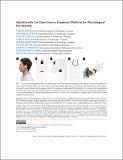| dc.contributor.author | R?ddiger, Tobias | |
| dc.contributor.author | K?ttner, Michael | |
| dc.contributor.author | Lepold, Philipp | |
| dc.contributor.author | King, Tobias | |
| dc.contributor.author | Moschina, Dennis | |
| dc.contributor.author | Bagge, Oliver | |
| dc.contributor.author | Paradiso, Joseph | |
| dc.contributor.author | Clarke, Christopher | |
| dc.contributor.author | Beigl, Michael | |
| dc.date.accessioned | 2025-04-07T15:33:25Z | |
| dc.date.available | 2025-04-07T15:33:25Z | |
| dc.date.issued | 2025-03-04 | |
| dc.identifier.issn | 2474-9567 | |
| dc.identifier.uri | https://hdl.handle.net/1721.1/159051 | |
| dc.description.abstract | Earphones have evolved from pure audio devices to "earables" that are capable of advanced sensing. Bespoke research devices have shown the unique sensing capabilities of the earable platform; however, they are hard to replicate and require expertise to develop in the first place. In this paper, we present OpenEarable 2.0 - an open source, unified platform that integrates a larger number of sensors for conducting comprehensive earable research. OpenEarable 2.0 works as regular binaural Bluetooth earphones and features two ultrasound capable microphones (inward/outward), a 3-axis ear canal accelerometer/bone microphone, a 9-axis head inertial measurement unit, pulse oximeter, optical temperature sensor, ear canal pressure sensor, and microSD card. These capabilities allow for the detection and measurement of 30+ phenomena on the ear that can be used across a wide range of applications in health monitoring, activity tracking, human-computer-interaction and authentication. We describe the design and development of OpenEarable 2.0 which follows best open hardware practices and achieves commercial-level wearability. We provide justification for the selection and placement of integrated sensors and include in-depth descriptions of the extensible, open source firmware and hardware that are implemented using free to use tools and frameworks. For real-time sensor control and data recording we also contribute a web-based dashboard and mobile smartphone app. The wearability and ability to sense different phenomena are validated in four studies which showcases how OpenEarable 2.0 provides accurate measurements in comparison to established gold-standard measurements. We further demonstrate that OpenEarable 2.0 can be assembled by inexperienced users, and that undergraduate students can build applications using the OpenEarable platform. | en_US |
| dc.publisher | ACM | en_US |
| dc.relation.isversionof | https://doi.org/10.1145/3712069 | en_US |
| dc.rights | Creative Commons Attribution | en_US |
| dc.rights.uri | https://creativecommons.org/licenses/by/4.0/ | en_US |
| dc.source | Association for Computing Machinery | en_US |
| dc.title | OpenEarable 2.0: Open-Source Earphone Platform for Physiological Ear Sensing | en_US |
| dc.type | Article | en_US |
| dc.identifier.citation | R?ddiger, Tobias, K?ttner, Michael, Lepold, Philipp, King, Tobias, Moschina, Dennis et al. 2025. "OpenEarable 2.0: Open-Source Earphone Platform for Physiological Ear Sensing." Proceedings of the ACM on Interactive, Mobile, Wearable and Ubiquitous Technologies, 9 (1). | |
| dc.contributor.department | Program in Media Arts and Sciences (Massachusetts Institute of Technology) | en_US |
| dc.relation.journal | Proceedings of the ACM on Interactive, Mobile, Wearable and Ubiquitous Technologies | en_US |
| dc.identifier.mitlicense | PUBLISHER_POLICY | |
| dc.eprint.version | Final published version | en_US |
| dc.type.uri | http://purl.org/eprint/type/JournalArticle | en_US |
| eprint.status | http://purl.org/eprint/status/PeerReviewed | en_US |
| dc.date.updated | 2025-04-01T07:52:25Z | |
| dc.language.rfc3066 | en | |
| dc.rights.holder | The author(s) | |
| dspace.date.submission | 2025-04-01T07:52:25Z | |
| mit.journal.volume | 9 | en_US |
| mit.journal.issue | 1 | en_US |
| mit.license | PUBLISHER_CC | |
| mit.metadata.status | Authority Work and Publication Information Needed | en_US |
